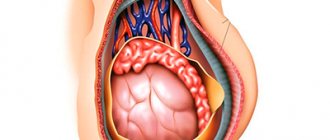Migraine is a neurological disease that is accompanied by many symptoms. Most often it is characterized by intense, debilitating headaches.
Symptoms may include nausea, vomiting, trouble speaking, numbness or tingling, and sensitivity to light and sound. They are often inherited and can appear at any age.
The disease is diagnosed based on medical history, described symptoms, and exclusion of other causes. The most common types of headaches are those without an aura (also known as regular migraines) and those with an aura.
Migraines sometimes begin in childhood or only occur in adulthood. Women suffer from them more often than men. Heredity is one of the factors.
Symptoms
Migraine symptoms may appear a day or two before the headaches begin.
This is called the prodrome stage. At this stage, symptoms may include:
- Food cravings
- Depression
- Fatigue or lack of energy
- Frequent yawning
- Hyperactivity
- Irritability
- Neck stiffness
The aura appears after the prodrome stage. During an aura, you may experience problems with vision, touch, movement and speech. Examples of such difficulties:
- Difficulty speaking clearly
- Tingling sensation on the face, arms and legs
- You see flashes of light or bright spots
- Temporary loss of vision
The next stage is an attack. This is the most acute and severe stage when migraine occurs directly. In some people it may replace or occur during the aura. The attack can last from several hours to several days. Symptoms may appear differently in different people. Some of them may be as follows:
- Increased sensitivity to light and sound
- Nausea
- Pain on one side of the head, or on the left, on the right, or in the front, or behind, or in the temples
- Throbbing headache
- Vomit
After an attack, the postdrome stage usually begins. At this stage, changes in feelings and moods occur. They “jump” from feelings of euphoria and happiness to feelings of fatigue and apathy. A mild, dull headache will persist.
The duration and intensity of these stages occur to different degrees in different people. Sometimes one of the stages may be completely absent and can pass without headaches.
Differences from migraine without aura
Migraine without aura is called “classic”. Approximately 80% of patients suffer from it. A migraine without an aura manifests itself as throbbing pain at one point. It is not preceded by any visual, auditory or sensory impairment. Sometimes people don’t even realize that it’s a migraine, but think that they just have a headache. For this reason, patients do not go to the doctor, which is fraught with consequences.
You have migraine without aura if the following symptoms are present:
- 5 episodes of pain.
- The attacks last from 4 to 72 hours if you do not take medication.
- The pain throbs and is concentrated on one side of the head. The forehead, neck, and then the face or back of the head may hurt.
- With any physical activity the pain gets worse.
- There may be nausea, fear of light, sounds, voices.
Migraine pain
People describe the pain as:
- pulsating
- Rhythmic
- Drilling
- Beating
- Exhausting
It can also be severe and dull, but long-lasting. The pain is mild at first, but without treatment it will increase from moderate to severe.
Migraine pain most often affects the forehead area. As a rule, on one side of the head, but maybe on both, or alternately. Most migraines last about 4 hours. If they are untreated or do not respond to treatment, they can last from 72 hours to a week. With an aura, pain is replaced by an aura or does not occur at all.
Literature
- Three generations of drugs;
- Search for drug targets;
- Sanoeva M.Zh. and Saidvaliev F.S. (2016). Migraine - yesterday, today, tomorrow. A modern view of the problem. "International Neurological Journal". 8, 72–78;
- How a migraine happens. Johns Hopkins Medicine;
- Migraine headaches. (2018). WebMD;
- Paul L. Durham. (2006). Calcitonin Gene-Related Peptide (CGRP) and Migraine. Headache
.
46 , S3-S8; - What to know about the new anti CGRP migraine treatment options. (2018). American Migraine Foundation;
- Silberstein S. D. (2016). Migraine. MSD Directory;
- Migraine triggers: your personal checklist. (2019). WebMD;
- Rusakova E. (2018). The FDA has approved the drug to prevent migraines. N+1;
- Kolata G. (2018). The FDA approves the first drug designed to prevent migraines. The New York Times;
- Theo Vos, Amanuel Alemu Abajobir, Kalkidan Hassen Abate, Cristiana Abbafati, Kaja M Abbas, et. al.. (2017). Global, regional, and national incidence, prevalence, and years lived with disability for 328 diseases and injuries for 195 countries, 1990–2016: a systematic analysis for the Global Burden of Disease Study 2021. The Lancet
.
390 , 1211-1259; - Francesca Puledda, Kevin Shields. (2018). Non-Pharmacological Approaches for Migraine. Neurotherapeutics
.
15 , 336-345; - Doodipala Samba Reddy. (2013). The pathophysiological and pharmacological basis of current drug treatment of migraine headache. Expert Review of Clinical Pharmacology
.
6 , 271-288; - Ogbru A. and Ogbru O. Prescription migraine medications. RxList;
- Boyce S., Ali Z., Hill R. G. (2001). New developments in analgesia. Drug Discovery World;
- Azimova Yu.E. (2017). Triptans: an era of specific treatment for migraine. "Nervous diseases". 1, 10–14;
- Ameri M. and Lewis H. (2018). The evolution of transdermal drug delivery and treating migraine. Drug Discovery World;
- Migraine medications. (2013). TMedWeb;
- Dmitriev R. (2019). "Aimovig" will turn chronic migraine into episodic. "Mosmedpreparaty";
- Aimovig (erenumab) for the treatment of episodic migraine. Clinical Trials Arena;
- Khoruzhaya A. (2018). A new anti-migraine drug goes on sale. "Neuronews";
- Targeted therapy is a targeted strike against the disease.
Nausea with migraine
More than half of people experience nausea along with other symptoms. And most of them also vomit. These symptoms may appear simultaneously with a headache. Although they usually appear an hour after the headache begins.
Nausea and vomiting can be just as troublesome as a headache. If you only have nausea, you can take your regular medications. But vomiting can prevent you from taking the pills or keeping them in your body long enough for them to be absorbed. If you have to delay taking your medications, your pain will only get worse.
If you have nausea but no vomiting, your doctor will recommend medications to relieve nausea, known as antinausea or antiemetic medications. In this case, an antiemetic will help prevent vomiting and reduce nausea.
Acupressure is very helpful in treating nausea associated with migraines. A 2012 study found that acupressure reduced the intensity of nausea after 30 minutes, and improved after 4 hours.
Simultaneous treatment of nausea and vomiting
Instead of treating nausea and vomiting separately, doctors prefer to relieve these symptoms by treating the migraine itself. If accompanied by severe nausea and vomiting, you may want to talk to your doctor about taking preventative medications.
Migraine tests
Doctors diagnose migraines by analyzing symptoms, medical history and family history, and performing a physical examination to rule out possible causes. Scans such as a CT scan or MRI can rule out other causes, including:
- Tumors
- Abnormal brain structures
- Stroke
Modern medicines
A special project about modern medicines, the history of their creation, development methods and development trends.
The special project partner, Cytiva, was formed as a result of the sale of the GE Healthcare Biopharma division to Danaher Corporation. Cytiva is a global provider of technologies and services that advance and accelerate the development and manufacturing of therapeutics. The company has a rich heritage dating back hundreds of years. Cytiva's clients conduct life-saving activities ranging from basic biological research to the development of innovative vaccines, biologics and novel cell and gene therapies. The company's mission is to provide the tools and services they need to do things better, faster and safer, leading to better outcomes for patients.
The first two articles of our special project “Modern Medicines” were devoted to general issues of how the drug industry developed [1] and how scientists search for new drug targets [2]. This article opens a number of news materials about interesting modern medicines.
Treatment
There is no cure, but your doctor can help you manage it so you suffer less from it and treat symptoms when they appear. Treatment may also help make your migraines less severe.
Your treatment plan depends on:
- Your age
- How often do you suffer from migraines?
- Like
- How severe it is, depending on how long it lasts, how much pain it causes, and how often it prevents you from going to school or work
- Whether it is accompanied by nausea and vomiting and other symptoms
- Do you have any other medical conditions and what medications are you taking?
Your treatment plan may include the following combination:
- Migraine remedies
- Lifestyle changes, including managing stress and preventing migraines
- Pain medications such as NSAIDs or acetaminophen
- Medicines you take daily to prevent headaches and reduce the frequency of headaches
- Medicines you take as soon as your headache starts to keep the pain from getting worse and to help relieve the symptoms.
- Medicines that help with nausea or vomiting
- hormonal therapy if there is suspicion that the disease is related to your menstrual cycle
- consulting
- alternative methods that may include biofeedback, meditation, acupressure, or acupuncture
Migraine remedies
There are some methods you can try at home that may also help relieve the pain: Lie down in a quiet, dark room. Massage your scalp or temples. Place a cold cloth on your forehead or neck. Many people also use herbal home remedies to relieve migraines.
Medicines
Medicines can be used to either prevent migraines from occurring or treat them once they occur. You may feel better by taking over-the-counter medications. However, if such drugs are not effective, your doctor will decide to prescribe other drugs.
This will depend on the severity of your migraine and whether you have any other medical conditions. Treatment options can focus on both prevention and treatment during an attack.
Headache from medication overuse
Frequent, chronic use of any type of headache medication can cause what is called overuse. People with migraines are at higher risk of developing this complication.
As you determine how to manage your pain, talk to your doctor about how often you take your medications and alternative remedies.
Surgical methods of treatment
There are several surgical procedures that have been used to treat migraines. However, they have not been approved by the US Food and Drug Administration. These methods include neurostimulation procedures and trigger site decompression surgery (MTSDS).
The American Migraine Foundation encourages anyone considering surgical treatment to see a neurologist (headache specialist) who is board-certified in the field.
Neurostimulation surgeries
During these operations, the surgeon inserts electrodes under the skin. Electrodes provide electrical stimulation to specific nerves. Several types of stimulants are used today:
- occipital nerve stimulators
- deep brain stimulants
- vagus nerve stimulants
- sphenopalatine ganglion stimulators
Insurance is rarely provided for stimulants. Research continues regarding the expected role of neural stimulation in the treatment of headaches.
Migraine Trigger Site Decompression Surgery (MTSDS)
This surgical procedure involves releasing nerves around the head and face that may be triggers for chronic migraines. Botox injections are typically used to identify the trigger nerves involved during a migraine attack. During sedation, the surgeon deactivates or decompresses isolated nerves. Typically, such operations are performed by plastic surgeons.
The American Migraine Society does not endorse treatment with these methods. They recommend that anyone considering such surgery first consult with a specialist to identify possible risks.
Such surgeries are considered experimental until further research proves they work consistently and are safe. However, they may have a role for people with chronic migraine who have not responded to other treatments.
Nomigren
A combined drug for relieving headache attacks of vascular origin, it helps people with migraine well. Nomigren is a relatively safe drug that contains propyphenazone, caffeine, ergotamine, meclosamine and kamilofin. "Nomigren" relieves headaches not only of a migraine nature - it is an antispasmodic and analgesic. When taking Nomigren for the first time, choose the minimum dosage, since the list of contraindications and side effects of the drug, despite its relative safety, is large.
Nomigren
Bosnalek, Bosnia and Herzegovina
acute attacks of migraine (including those accompanied by an aura);
migraine-like headaches of vascular origin. from 127
5.0 3 reviews
1184
- Like
- Write a review
What causes migraines?
Researchers have not determined the cause. They have found some contributing factors that may lead to this disease. These include changes in brain chemicals, such as a decrease in the amount of serotonin in the brain.
Other factors that can cause migraines include:
- bright lights
- extreme heat or other extreme weather conditions
- dehydration
- changes in atmospheric pressure
- hormonal changes in women, such as fluctuations in estrogen and progesterone during menstruation, pregnancy, or menopause
- excessive stress
- loud sounds
- intense physical activity
- skipping meals
- changes in sleep patterns
- using certain medications such as oral contraceptives or nitroglycerin
- unusual smells
- certain food
- smoking
- alcohol consumption
- trips
If you suffer, your doctor may ask you to keep a headache journal. Writing down everything you did, what food you ate, and what medications you took before your migraine started can help identify your triggers.
Foods that cause migraines
Some foods or food ingredients are more likely to cause it than others. They include:
- alcoholic or caffeinated drinks
- food additives such as nitrates (a preservative in cured meats), aspartame (an artificial sugar), or MSG
- tyramine, which is found in some natural foods
Tyramine also increases when foods begin to ferment or are aged. This includes foods such as some aged cheeses, sauerkraut and soy sauce. Ongoing research is looking more closely at the role of tyramine in migraines. For some people it may be a headache protector, but for others it may be a headache trigger.
Types
There are many types. The two most common types are without aura and with aura. Some people have both types.
Migraine without aura
This type used to be called common migraine.
According to the International Migraine Society, people with migraine without aura have had at least five attacks that have the following characteristics:
- A headache attack usually lasts from 4 to 72 hours if left untreated or if treatment does not help.
- A headache has at least two of the following features:
- it only occurs on one side of the head
- throbbing pain
- pain level is moderate to severe
- pain worsens with movement, such as walking or climbing stairs
- The headache has at least one of these features:
- Sensitivity to light appears (photophobia)
- Sensitivity to sound appears (phonophobia)
- You experience nausea with or without vomiting or diarrhea
- The headache is not caused by another health problem or diagnosis.
Migraine with aura
This type was previously called classical, complicated and hemiplegic. Migraine with aura occurs in 25 percent of people.
According to the International Migraine Society, you must have had at least two attacks with the following characteristics:
- An aura that disappears may return and includes at least one of the following symptoms:
- vision problems (the most common aura symptom)
- sensory problems such as numbness, tingling, or dizziness
- problems with speech or language
- trouble moving or weakness that may last up to 72 hours
- brain stem symptoms:
- difficulty communicating or dysarthria (fuzzy speech)
- dizziness
- tinnitus
- Hypacusis (hearing problems)
- diplopia (double vision)
- ataxia, or inability to control body movements
- clouding of consciousness
- vision problems in only one eye, including flashes of light, blind spots, or temporary blindness (when these symptoms occur, they are called retinal migraines)
- An aura that has at least two of these traits:
- at least one symptom gradually gets worse over five minutes or more
- Each aura symptom lasts from five minutes to one hour (if you have three symptoms, they can last up to three hours)
- at least one aura symptom affects only one side of the head, including problems with vision, speech, or language
- aura occurs with headache or an hour before headache begins
- The headache was not caused by another medical problem, and a temporary ischemic attack was ruled out.
The aura usually occurs before the headache begins, but it may continue during the headache. In some cases, the aura may begin at the same time as the headache.
Chronic migraine
Chronic headaches used to be called combined or mixed headaches because they can have features of migraines and tension headaches. It is also sometimes called severe and can be caused by overuse of medications.
People with chronic migraines experience severe tension more than 15 days per month for 3 or more months. More than eight of these headaches are migraines with or without aura.
- severe headaches
- major incapacity
- depression
- another chronic illness, such as arthritis
- other serious health problems (comorbidities), such as high blood pressure
- previous head or neck injuries
Acute migraine
Acute is a general term that is not diagnosed as chronic. Another name for this type is episodic. People who suffer from episodic migraines experience headaches up to 14 days a month. Thus, people with episodic migraines suffer less headaches than people with chronic ones.
Vestibular migraine
Vestibular is also known as vertigo. About 40 percent of people have some symptoms related to the vestibular system. These symptoms make it difficult to balance, cause dizziness, or both. People of any age, including children, can experience vestibular migraines.
Neurologists typically treat people who have difficulty coping with migraines, including vestibular migraines. For this type of migraine, the same medications are prescribed as for its other types. Vestibular migraines are also sensitive to foods that trigger migraines. So, you can prevent or reduce dizziness and other symptoms by making changes to your diet.
Your doctor may also recommend that you see a vestibular rehabilitation therapist. He or she can teach you exercises that will help you maintain balance when your symptoms are at their worst. Because they are so debilitating, you and your doctor may want to discuss taking preventive medications.
Optical migraine
Optical is also known as ophthalmic, ocular, ophthalmic, monocular and retinal migraine. This is a rarer type with an aura, but unlike other visual auras, it only affects one eye.
The International Migraine Society defines retinal migraines as attacks of completely reversible and temporary vision problems in only one eye. Symptoms may include:
- flashes of light called scintillations
- blind spot or partial loss of vision called scotomata
These vision problems usually occur within an hour of the headache. Sometimes optical migraines are painless. Most people with optical migraine have previously had another type of migraine.
Physical activity can trigger an attack. These headaches are not caused by eye problems such as glaucoma.
Complex migraine
Complex headache is not a type of headache. Some people refer to "complex migraine" as migraine with aura, which has symptoms similar to those of a stroke. These symptoms include:
- weakness
- speech problems
- loss of vision
Seeing an appropriate specialist will help you get a correct and accurate diagnosis.
Menstrual migraine
Menstruation-related pain affects up to 60 percent of women. They may or may not be accompanied by an aura. They can also occur before, during or after menstruation and during ovulation.
Research has shown that menstrual migraines are more intense, last longer, and are more likely to cause nausea than other migraines.
In addition to standard treatment, women with menstrual migraines will benefit from medications that affect serotonin levels, as well as hormonal treatments.
Acephalgic migraine
Acephalgic is also known as migraine without headache, aura without headache, silent and visual migraine without headache. An acephalgic migraine occurs when a person experiences an aura but does not have a headache. This type is not uncommon among people who begin migraines after 40 years of age.
Visual aura symptoms are the most common. With this type, the aura may appear gradually, with symptoms spreading over several minutes and moving from one symptom to another. After visual symptoms, people may experience numbness, problems speaking, and then feel weak and unable to move parts of their body normally.
Hormonal migraine
Also known as exogenous estrogen headaches, hormonal headaches are associated with female hormones, usually estrogens. These include migraines during:
- your menstruation
- ovulation
- pregnancy
- perimenopause
- the first few days after starting or stopping medications that contain estrogen, such as birth control pills or hormone therapy
If you are taking hormone therapy and your headaches are getting worse, your doctor may suggest:
- adjust the dose
- take a different type of hormone
- stopping hormone therapy
Migraines from stress
Stress migraines are not a type of migraine recognized by the International Migraine Society. Stress may be the cause.
There are headaches that arise from stress. They are also called tension headaches. If you think stress may be causing a migraine, try yoga for relaxation.
Cluster migraine
Cluster is also not included in the classification of the International Migraine Society. However, cluster headaches do exist. These headaches cause severe pain around and behind the eye, often accompanied by:
- tearing
- nasal congestion
- redness
They can be triggered by alcohol or excessive smoking. You may suffer from both cluster headaches and migraines.
Vascular migraine
Vascular is not included in the classification of the International Migraine Society. Vascular headache is a term some people use to describe the throbbing and throbbing headaches caused by migraines.
Targeted therapy for migraine: a solution to the problem?
Since migraine is a chronic disease and the effectiveness and safety of the drugs used for prevention is poor, there is clearly an unmet need in this area; however, there are few new drugs specifically developed for this indication [14].
Amgen and Novartis can boast of a breakthrough today, having received approval in May 2021 for the use of the targeted drug Aimovig erenumab antibodies ) for the prevention of migraine in adult patients [20]. This is the first fully human antibody to be commercialized whose preventive effect is due to binding and blocking the CGRP receptor, which is considered critically important in the development of migraine (Fig. 3).
Figure 3. Aimovig specifically binds to the CGRP receptor, preventing CGRP from binding to it. The binding of CGRP to its receptor in a molecular complex (shown on the left) results in the transmission of pain signals associated with migraine. In people with migraine, CGRP levels are elevated during a painful attack and return to normal levels when the migraine pain subsides.
About Aimovig® (erenumab) in migraine prevention
Aimovig was approved after three series of clinical trials, the results of which, although slightly different, were similar in one thing: the drug showed a significant reduction in the number of days with attacks and the total duration of migraine pain. Moreover, in phase III trials, in 50% of patients taking 140 mg of Aimovig, the number of painful days decreased by half compared to placebo, and the safety and tolerability of the drug turned out to be quite similar to placebo [21], [22]. . These results are very encouraging, and it is clear that although Aimovig is not a panacea, its use will definitely change the lives of patients suffering from frequent and severe migraines for the better.
Antibody purification using continuous countercurrent chromatography
Biotechnologically derived antibodies can be purified using the chromatography equipment of this material's partner, Cytiva. This is done in continuous counter-current chromatography (PCC) mode on an ÄKTA pcc . In combination with the minimal dimensions of the system, continuous chromatography technology ensures the most efficient use of the chromatographic sorbent (resin). This method is particularly suitable for the purification of unstable molecules, as the rapid process ensures the stability of the target product. The ÄKTA pcc system is based on the well-established and widely used ÄKTA chromatography system platform by scientists around the world. Key features of the ÄKTA pcc system:
- Flow rate: 0.5–75 ml/min.
- Maximum operating pressure: 20 bar.
- Supports three and four column PCC configuration (3C and 4C PCC).
- Integrated UV detectors: one tunable wavelength (three values) and three fixed wavelength (280 nm).
- Monitors for tracking pH and conductivity readings.
- Interactive visualization that continuously shows column status and process progress.
- Trend lines that allow you to immediately begin analyzing the information received about the process.
ÄKTA chromatography systems can be used in conjunction with AxiChrom columns, although they are also suitable for larger scale protein purifications. A wide range of column sizes of the same type (Figure 4) allows protein purification to be scaled up with minimal parameter changes.
Figure 4. AxiChrom is a family of pilot-scale to industrial-scale protein purification columns with i.d. diameters of 50–1600 mm. AxiChrom columns successfully combine standardization and customization and are compatible with a variety of advanced media, such as MabSelect SuRe™ antibody purification resin.
Cytiva's research has confirmed the similarity between the protein purified in the laboratory and in production. In this case, the volume of the drug was scaled by 294 times (Fig. 5).
Figure 5. Comparison of chromatograms obtained using ÄKTA pcc on HiTrap columns (a) and AxiChrom 50 columns (b)
Material provided by our partner - Cytiva
Migraine in children
Children can experience the same types of migraines as adults. Children and teenagers, like adults, may also experience depression and anxiety disorders along with migraines.
Until they are adults, teenagers and children may have symptoms on both sides of the head. Children rarely have headaches in the back of the head. Their migraines typically last between 2 and 72 hours.
There are types that are most common in children. These include abdominal migraine, benign paroxysmal vertigo and cyclic vomiting.
Abdominal migraine
Children with abdominal pain experience abdominal pain instead of a headache. The pain may be moderate to severe. Typically the pain occurs in the middle of the abdomen, around the navel. However, the pain may not necessarily be located in this area. The stomach may simply “ache.”
Your child may also have a headache. Other symptoms include:
- lack of appetite
- nausea with or without vomiting
- sensitivity to light or sound
Children with abdominal migraines may also develop more typical symptoms seen in adults.
Benign paroxysmal vertigo
Benign paroxysmal vertigo can occur in babies who are just starting to walk, or simply in young children. This occurs when your child suddenly loses the ability to stand on his own feet and refuses to walk or walks with his legs wide apart, as if he is staggering. He may feel nauseous. He may also experience a headache.
Another symptom is rapid eye movements (nystagmus). The attack lasts from several minutes to several hours. Sleep often stops these symptoms.
Cyclic vomiting
Cyclic vomiting is common in school-age children. Forced vomiting may occur four to five times per hour for at least one hour. Your child may also suffer from:
- stomach ache
- Headache
- sensitivity to light or sound
Symptoms may last for 1 hour or up to 10 days.
Between episodes of vomiting, your child may act and feel completely normal. Attacks may occur once a week or less frequently. Symptoms may begin to appear in a pattern that is easily recognizable and predictable.
Symptoms of cyclic vomiting may be more noticeable than other migraine symptoms experienced by children and adolescents.
Amigrenin
The active ingredient of Amigrenin is also sumatriptan, but in a higher dosage than the previous medicine. Amigrenin quickly relieves migraine symptoms, not only headaches, but also other symptoms. Moreover, if you take a pill at the beginning of the aura, you can even avoid a headache. The drug contains a high dosage of sumatriptan - 100 mg - which is why Amigrenin has such a large list of contraindications.
Amigrenin
Veropharm / Lance-Farm, Russia
The active substance of the drug Amigrenin interacts with type I 5-hydroxytryptamine receptors located in the smooth muscles of the walls of blood vessels in the brain, selectively constricts blood vessels in the carotid artery system, and inhibits the activity of the trigeminal nerve.
All this helps reduce the severity of migraine pain. The clinical effect is observed after 30 minutes. from 187
712
- Like
- Write a review
Migraine and pregnancy
For many women, migraines ease slightly during pregnancy. However, after childbirth it may become worse due to sudden hormonal changes. Headaches during pregnancy require special attention to properly understand the causes of their occurrence.
Research is ongoing, but a recent small study found that women who experience migraines during pregnancy are more likely to:
- premature or early birth
- preeclampsia
- giving birth to an underweight child
Some medications are not recommended to be taken during pregnancy. For example, aspirin. If you experience migraines during pregnancy, talk to your doctor to find treatment options that won't harm your baby.
Migraine and headache: tension
Tension headaches, the most common type of headache, have some similar symptoms. However, migraines are also associated with many symptoms not associated with tension headaches.
And tension headaches can be characterized by:
- mild to moderate pain
- constant pain
- pain on both sides of the head
These symptoms are typical only for migraines:
- moderate to severe pain
- throbbing pain
- inability to carry out one's usual activities
- pain on one side of the head
- nausea with or without vomiting
- aura
- sensitivity to light, sound, or both
Sumatriptan
This drug is one of the best in the fight against persistent migraine. The active ingredient of the drug is sumatriptan succinate. "Sumatriptan" selectively constricts blood vessels without affecting cerebral blood flow. The drug not only relieves headaches, but also helps relieve other symptoms of migraine: sensitivity to light and noise, nausea. The migraine subsides just 15 minutes after taking the pill. Sumatriptan is a drug with a stable effect, so migraine attacks do not return for a long time after taking it.
Sumatriptan
Migraine prevention
You can take the following steps to help prevent:
- Drink the required amount of liquid. Men should drink about 13 glasses of fluid per day, and women should drink about 9.
- Avoid skipping meals.
- Better get enough sleep. A good night's sleep is important for overall health.
- Quit smoking.
- Make it a goal to avoid stress in your life and learn how to cope with it.
- Learn relaxation skills.
- Exercise regularly. Exercise can not only help you reduce stress, but also help you lose weight. Experts link obesity to migraines. Start your workout gradually so you can gradually warm up. Starting a workout too abruptly and intensely can cause migraines.
Talk to your doctor
Sometimes symptoms can mimic those of a stroke. It is important to see your doctor immediately if you or someone you love experiences a headache that:
- causes slurred speech or drooping of one side of the face
- causes unusual weakness in the legs or arms
- comes on very suddenly and sharply, without symptoms or warnings
- occurs with fever, neck stiffness, confusion, seizure, double vision, weakness, numbness, or difficulty speaking
- has an aura whose symptoms last more than an hour
- became the worst headache
- accompanied by loss of consciousness
- Make an appointment with your doctor if your headaches begin to affect your daily life. Tell him if you experience pain around your eyes or ears, or if you suffer from headaches many times a month that last several hours or days.
Migraine headaches can be severe, debilitating, and uncomfortable. There are many treatment options, so be patient and find the option that works best for you. Be aware of your headaches and symptoms so you can determine what is triggering your migraines. Knowing how to prevent migraines can often be the first step in managing them.
"Aimovig" and competitors
It must be said that Novartis and Amgen already have serious competitors in the field of targeted anti-migraine therapy: Eli Lilly released Emgality, and Teva Pharmaceutical released Ajovy. These drugs are humanized monoclonal antibodies that target the ligand rather than the CGRP receptor, and in this way they differ from Aimovig, being inferior to the latter at least in tolerability. When using Ajovy, 43–45% of patients experienced pain, redness and itching at the injection site, when using Emgality, 18% of patients experienced such symptoms, and Aimovig caused such reactions only in 5–6% of cases. At the same time, Aimovig is also more convenient to use, since of the three listed drugs, only it comes in the form of an auto-injector - a device that resembles an insulin syringe pen - which needs to be used only once a month. The listed advantages, coupled with the fact that Aimovig became the first targeted drug for the treatment of migraine and immediately filled an empty niche in the market, will most likely provide it with a bright financial future: according to experts, its market share in 2024 will be $2 billion, while the predicted shares of competitors are approximately half as much [20].
The success of Aimovig, apparently, cannot be hampered even by the extremely high price ($575 per month according to the Amgen price list - however, in the United States, the drug is covered by insurance for many patients), which, by the way, some experts consider unreasonable [11]. The company is conducting research on Aimovig in Russia, but when the drug will appear on the market, how much it will cost and who will pay for it is still unknown.









